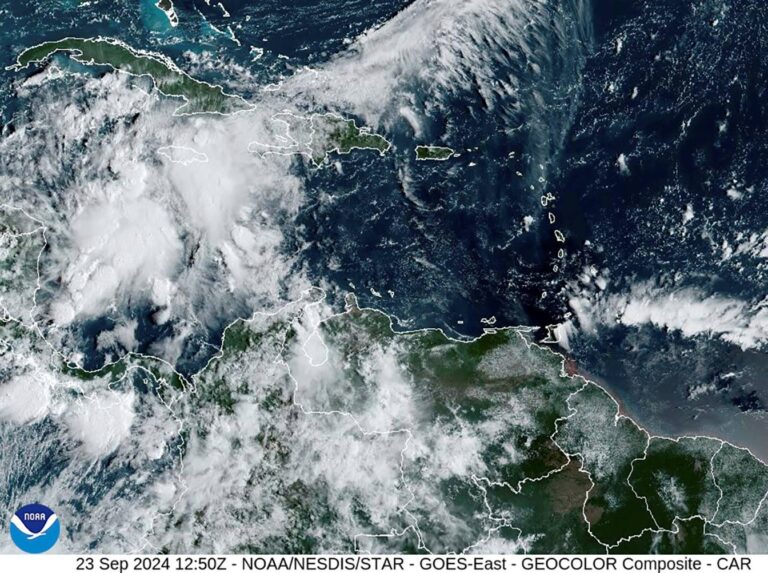Tuesday, Sept. 24, 2024, 10:30 am central time: Updated to reflect current weather conditions.
SAN JUAN, Puerto Rico — Heavy rains and big waves lashed the Cayman Islands on Tuesday, Sept. 24, as forecasters warned that a nearby cluster of thunderstorms could soon become a major hurricane en route to the southeast U.S.
Hurricane watches were in effect for Florida’s Tampa Bay and from Englewood to Indian Pass, as well as for eastern Mexico from Cabo Catoche to Tulum and for Cuba’s Pinar del Rio province. Hurricane conditions could be possible in parts of Cuba and Mexico early Wednesday and in parts of Florida late Wednesday and early Thursday, according to the National Hurricane Center.
“Now is the time to start preparing. If you’re in an evacuation zone, you should evacuate,” said Lisa Bucci, a hurricane specialist at the center. “Don’t be fooled by the way the storm looks at the moment. We are expecting it to rapidly intensify.”
She said people in regions under watches and warnings should be prepared to lose power and should have enough food and water for at least three days.
The disturbance is expected to move “over extremely deep and warm waters” that would fuel its intensification.
“Conditions look quite favorable for strengthening over the eastern Gulf of Mexico on Wednesday and Thursday,” the center said. “This system will become quite large and powerful before landfall.”
The disturbance is expected to become Tropical Storm Helene on Tuesday and then strengthen into a Category 3 hurricane before approaching the northeast Gulf Coast. Since 2000, eight major hurricanes have made landfall in Florida, according to Philip Klotzbach, a Colorado State University hurricane researcher.
Given the anticipated large size, storm surge, wind and rain will extend far from the center of the expected storm, especially on the east side. The center warned of “inland penetration of strong winds over parts of the southeastern United States after landfall.”
Bucci said states including Tennessee, Kentucky and Indiana could see rainfall associated with the storm.
A tropical storm warning was in effect for Grand Cayman; for eastern Mexico from Rio Lagartos to Tulum; and for Cuba’s Artemisa, Pinar del Rio and the Isle of Youth.
Meanwhile, a storm surge watch was in effect for Florida’s Tampa Bay, Charlotte Harbor and from Indian Pass south to Flamingo. A tropical storm watch was issued for Dry Tortugas, the Lower Keys west of the Seven Mile Bridge, Flamingo to the south of Englewood and from west of Indian Pass to the Walton Bay county line.
The National Weather Service in Tallahassee, Florida, urged people to take potential evacuations seriously.
“10-15ft of surge is NOT survivable,” it wrote on the social media platform X.
On Monday, Florida Gov. Ron DeSantis declared a state of emergency in 41 counties.
The disturbance was expected to strengthen into a major hurricane as it approaches the northeast Gulf Coast on Thursday. It was located about 150 miles west of Grand Cayman. It had maximum sustained winds of 35 mph and was moving northwest at 9 mph.
Officials in the Cayman Islands shuttered schools and airports as forecasters warned of heavy wind and rain and waves of up to 10 feet.
“The current conditions present significant risk, and we must prioritize our safety,” said Ian Yearwood with the Royal Cayman Islands Police Service.
Meanwhile, many in Cuba worried about the disturbance, whose tentacles are expected to reach the capital of Havana, which is struggling with a severe shortage of water and piles of uncollected garbage.
Overall, roughly 600,000 people in Cuba are experiencing water shortages, including more than 130,000 in Havana alone. Chronic power outages also persist.
The disturbance is expected to slip through waters separating Cuba from Mexico’s Yucatán Peninsula late Tuesday and then head north to the Gulf Coast.
Up to 8 inches of rain is forecast for western Cuba and the Cayman Islands with isolated total of some 12 inches. Up to 4 inches of rain is expected for the eastern Yucatán Peninsula, with isolated total of more than 6 inches.
Heavy rainfall also is forecast for the southeast U.S. starting on Wednesday, threatening flash and river flooding, according to the National Hurricane Center. Up to 6 inches of rain was forecast for the region, with isolated totals of 10 inches.
A storm surge of up to 15 feet was forecast from Ochlockonee River, Florida, to Chassahowitzka, and up to 10 feet from Chassahowitzka to Anclote River and from Indian Pass to Ochlockonee River.
Helene would be the eighth named storm of the Atlantic hurricane season that runs from June 1 to Nov. 30.
The National Oceanic and Atmospheric Administration has predicted an above-average Atlantic hurricane season this year because of record-warm ocean temperatures. It forecast 17 to 25 named storms, with four to seven major hurricanes of Category 3 or higher.
The Associated Press is an independent global news organization dedicated to factual reporting. Founded in 1846, AP today remains the most trusted source of fast, accurate, unbiased news in all formats and the essential provider of the technology and services vital to the news business. The Trucker Media Group is subscriber of The Associated Press has been granted the license to use this content on TheTrucker.com and The Trucker newspaper in accordance with its Content License Agreement with The Associated Press.







